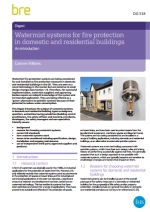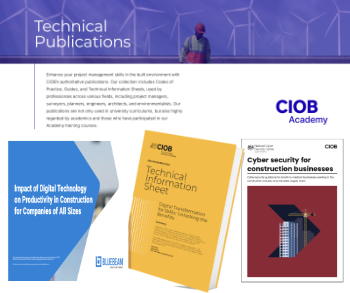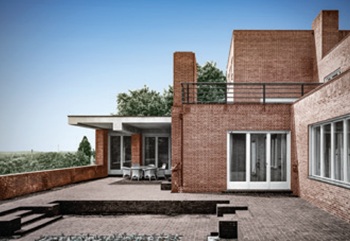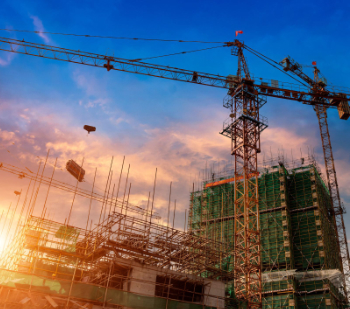Watermist systems for fire protection in domestic and residential buildings DG 534
BRE (Building Research Establishment) is an independent, research-based consultancy, testing and training organisation, operating in the built environment and associated industries.
Watermist systems for fire protection in domestic and residential buildings: An introduction (DG 534) was published by BRE on 10 September 2014. It was written by Corinne Williams.
A form of watermist was first used for the protection of assets from fire in industrial applications in the 1930’s. More recently they have been used for the protection of spaces on board ships and for industrial and commercial applications. Watermist fire protection systems are now being considered for installation as fire protection measures in domestic and residential buildings in the UK. They can be considered a ’green’ alternative to automatic sprinkler systems because of their potential to reduce water consumption, although they are seen as a novel technology in the market.
Watermist fire protection systems are sensitive to small design changes and so successful implementation requires in-depth knowledge of the system and its intended application from watermist suppliers and approving bodies.
This 12 page digest provides an introduction to watermist systems in domestic and residential buildings for designers, specifiers, authorities such as building control bodies, fire safety officers and insurers, clients, developers, fire safety managers and non-specialists. It covers the general background, reasons for choosing watermist systems, current UK standards, how watermist systems work, issues to be considered during specification, design, installation and ongoing maintenance, the use of independent third-party approved suppliers, and products.
The contents of the digest include:
- Introduction.
- Description of domestic and residential watermist systems and how they work.
- Standards.
- System fire performance tests.
- Planning and specification.
- Design, installation and commissioning.
- Ongoing maintenance, system continuity and documentation.
- Alternative suppression systems.
- Use of independent third-party approved suppliers and products.
- Conclusions.
- References.
- Further information.
[edit] Related articles on Designing Buildings Wiki
- Automatic fire sprinkler systems: A good practice guide.
- BRE articles on Designing Buildings Wiki.
- BRE Buzz articles on Designing Buildings Wiki.
- BRE Buzz.
- Building Research Establishment.
- Design benefits of automatic sprinkler systems granted under approved document B.
- Evaluation of cooling effects: outdoor watermist fan.
- Fire in buildings.
- Fire protection engineering.
- Fire safety design.
- Making the case for sprinklers and dispelling myths.
- Personal protection watermist systems in the homes of vulnerable people.
- Sprinkler systems explained: A guide to sprinkler installation standards and rules.
- Sprinkler.
- The impact of automatic sprinklers on building design.
Featured articles and news
The benefits of precast, off-site foundation systems
Top ten benefits of this notable innovation.
Encouraging individuals to take action saving water at home, work, and in their communities.
Takes a community to support mental health and wellbeing
The why of becoming a Mental Health Instructor explained.
Mental health awareness week 13-18 May
The theme is communities, they can provide a sense of belonging, safety, support in hard times, and a sense purpose.
Mental health support on the rise but workers still struggling
CIOB Understanding Mental Health in the Built Environment 2025 shows.
Design and construction material libraries
Material, sample, product or detail libraries a key component of any architectural design practice.
Construction Products Reform Green Paper and Consultation
Still time to respond as consultation closes on 21 May 2025.
Resilient façade systems for smog reduction in Shanghai
A technical approach using computer simulation and analysis of solar radiation, wind patterns, and ventilation.
Digital technology, transformation and cybersecurity
Supporting SMEs through Digitalisation in Construction.
Villa Wolf in Gubin, history and reconstruction. Book review.
[[w/index.php?title=W/index.php%3Ftitle%3DW/index.php%3Ftitle%3DW/index.php%3Ftitle%3DW/index.php%3Ftitle%3DW/index.php%3Ftitle%3DConstruction_contract_awards_down_1bn%26action%3Dedit%26redlink%3D1%26action%3Dedit%26redlink%3D1%26action%3Dedit%26redlink%3D1%26action%3Dedit%26redlink%3D1%26action%3Dedit%26redlink%3D1&action=edit&redlink=1|Construction contract awards down £1bn]]
Decline over the past two months compared to the same period last year, follows the positive start to the year.
Editor's broadbrush view on forms of electrical heating in context.
The pace of heating change; BSRIA market intelligence
Electric Dreams, Boiler Realities.
New President of ECA announced
Ruth Devine MBE becomes the 112th President of the Electrical Contractors Association.
New CIAT Professional Standards Competency Framework
Supercedes the 2019 Professional Standards Framework from 1 May 2025.
Difficult Sites: Architecture Against the Odds
Free exhibition at the RIBA Architecture Gallery until 31 May.
PPN 021: Payment Spot Checks in Public Sub-Contracts
Published following consultation and influence from ECA.
Designing Buildings reaches 20,000 articles
We take a look back at some of the stranger contributions.
Lessons learned from other industries.



























